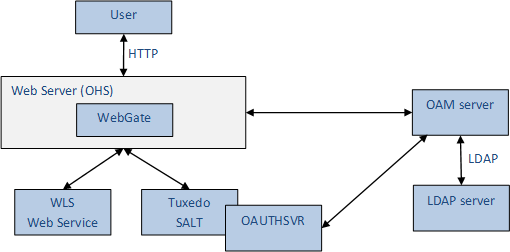2.1.5 OAM Integration
OAM integration only supports SALT inbound request, for HTTP
Basic Authentication GWWS will extract username and password and
calls Tuxedo AUTHSVC to authenticate the user,
OAUTHSVR will communicate with OAM to authenticate, if
it is successful then GWWS will retrieve OAM session token, the
session token will be passed in following service call,
OAUTHSVR will use the session token to authorize.
For WSSE situation, GWWS will use user credential received and
authenticate with Tuxedo, before it calls Tuxedo service it will
check if auth level is TPAPPAUTH and insert the
session token into context and call Tuxedo service.
If it is either X509 authentication or SAML SSO is used then it depends on whether Basic Authentication is attached to the request. If Basic Authentication is not attached to the request, Tuxedo cannot retrieve username and password, authorization will fail.
If you are already authenticated with WebGate and the OAM session token is exist in HTTP header, GWWS will extract the token and use it to authorize.
WebGate is a agent provided for various Web Servers (Oracle HTTP server - OHS, IBM HTTP server -IHS, Apache ...) as part of the OAM product. It is installed on different HTTP server, to use OAM for authentication and authorization, HTTP server and WebGate are necessary. Often the HTTP server works as reverse proxy to backend applications, such as WLS or SALT
For 11g WebGate, the OAM token cookie
(OAMAuthnCookie) is not passed to downstream
applications such as SALT, please specify WebGate user-defined
parameter filterOAMAuthnCookie to false.
For more information, see ans Setting up OAUTHSVR as the
Authentication Server and Registering Managing OAM 11g
Agents.
Figure 2-1 WebGate
